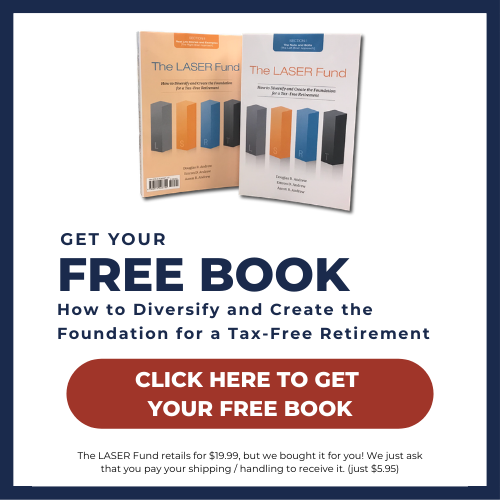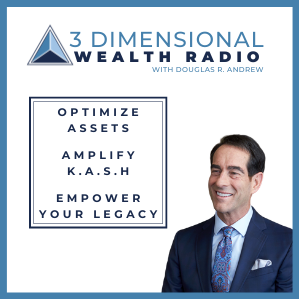How do banks make their money? And is it possible to become your own banker? Absolutely.
The key to becoming your own banker is to leverage the power of arbitrage.
THE POWER OF ARBITRAGE
Now, what exactly is arbitrage? The astute have used arbitrage to get ahead for centuries. In fact, in the Bible, the Parable of the Talents refers to arbitrage when the master approves of the first two servants who doubled their money, while rebuking the one who buried his talent.
Let’s look at how you can avoid “burying those talents” of yours to provide for an abundant future—and let’s start by considering what banks do.
When you put money into a bank, a credit union, or an insurance company, you’re actually loaning them your money, and they’re paying you interest for that loan.
Sometimes when people think about paying interest, their assumption is that paying interest is bad, something to avoid. But banks, credit unions, and insurance companies understand that paying interest can be good.
They borrow other people’s money (OPM) when customers make deposits, and they pay interest on those deposits. Over the last 20 years or so, many banks and credit unions have only paid 1% or 2% interest on deposits. So if you had put $1 million in a savings account, you likely would have earned only $10,000 a year.
What are they doing with your money? They’re putting it out into investments, or they’re loaning it back out again. So let’s look at some math. Let’s say they’re paying you 1% on the money you deposited. They’re loaning it out at 5%. What kind of profit is that? It’s not just a 4% profit. It is actually 500%, because on every $1 million they pay $10,000 on, they’re making $50,000. How much more is $50,000 than $10,000? It’s 500% more.
The difference between the interest they’re paying on deposits and the interest they’re earning on investments or loans is called arbitrage.
As a side note, when you put your money into an insurance policy, you’re likely going to be earning more than you would with banks. Insurance companies earn money on what’s called their General Account Portfolio, or money they borrow from the public. They might earn 5% on average, and at times when interest rates are high, that can be even higher. (For example, in the 1980s, insurance companies were earning 11% to 15%.) A good financial institution will pass on most of those earnings in the interest they credit to policies–which is one of the many reasons why my favorite financial vehicle is a properly structured, maximum-premium Indexed Universal Life policy.
THE “BECOME YOUR OWN BANKER” APPROACH
This concept of arbitrage is behind becoming your own banker. You may have heard that term from authors like Nelson Nash, who uses it in context of his “infinite banking” concept. It’s a solid approach; many Whole Life insurance professionals talk about the infinite banking concept.
For long-term investing, a lot of people understand the merits of socking away money into tax-favored vehicles, such as life insurance policies. When I started out in my profession, back in 1974, I was a big “buy term, invest the difference” proponent. Then I changed course after 1980, when EF Hutton essentially redesigned “buy term, invest the difference” under a tax-free umbrella. (For more details on the history of Indexed Universal Life, read my article, “What Is the Difference Between Term, Whole Life, and Indexed Universal Life Insurance?”
Now most people buy life insurance simply for the death benefit. With that goal, you’re trying to get the most insurance for the lowest premium, primarily to cover expenses for your heirs when you die.
EF Hutton’s approach was to turn things upside-down and use life insurance more for living benefits, than death benefits. With this approach, when you put money into an insurance contract for living benefits, you’re going to take the least amount of insurance that the IRS will let you get away with under the Internal Revenue Code, while putting in the most premiums as quickly as the tax citations will allow. Then an insurance policy can turn into a cash cow.
EF Hutton realized that insurance policies were the only financial vehicle that allows you to:
- Accumulate your money tax-free–all the growth is tax-free!
- Access your money tax-free–if you do it the smart way (see my article, ”What Is the Smartest Way to Access Cash out of an IUL?”)
- Transfer your money (which has grown in value) to your heirs income-tax-free when you pass away
Nothing else does that.
And what’s more, life insurance companies have proven to be even safer institutions than traditional banks and credit unions. During the Great Depression and the Great Recession, when hundreds of banks and other financial institutions folded, insurance companies came through with flying colors. The safest among them, the ones that have been around for over 100 years, are where I put my money
Even banks put their Tier 1 assets in insurance policies because they trust the safety and liquidity.
USING IUL TO BECOME YOUR OWN BANKER
Now let’s see how you can apply the principle of arbitrage and rest easy with the safety of insurance companies to become your own banker.
When we talk about historic returns with IUL policies, we’re looking at 5% to 10%. That’s a good return on your money. Personally, I have averaged 10.17% net cash on cash rate of return by using strategies I teach in my YouTube channel and books. That means every $1 million I put away in my policies generates $100,000 a year of tax-free income.
This is why I keep my working capital in the liquid, safe environment of properly structured, maximum-premium Indexed Universal Life policies (what I call a LASER Funds).
As an example, let’s say I have $1 million in my insurance policy in tax-free accumulation. This is my cash value. Now, let’s say I’m running my business, and I want to buy equipment like some of my clients do, so I need $100,000. I can contact my insurance company and access that $100,000 with an electronic funds transfer.
I check a box to indicate I want to borrow that money (not withdraw it), because I’m accessing my money the smart way. The insurance company says, “Your cash will stay in the policy as collateral, and we’ll loan you the equivalent of your cash.” So they loan me that $100,000.
People who don’t understand say, “Wait, you BORROWED your own money? Why would you do that?”
Keep reading; you’ll see why.
Now when I borrow money out of my policy, I have one of two choices. I can borrow the money in a Zero Wash Loan or an Alternate Loan. With the Zero Wash Loan, the insurance company will charge me interest, say 2% on that money, while the money that is still in my policy collateralizing the loan is earning 2%. It costs me nothing to borrow my money.
But I have another option–an Alternate Loan. I can say, “I want to leave the money in my policy and link it to an index.” With this approach, I know I can usually average a higher percentage rate of return, historically 5% to 10%. So my money stays in the policy and earns, let’s say 10%. Now the insurance company in this case will charge me a higher rate than the Zero Wash Loan, say around 4% or 5% (and they cap it at that). Let’s say they charge me 5%, and I’m earning 10%. I’m earning interest on the money I’ve borrowed, my own money, while I’m still taking care of my business expenses.
Does this make sense? In 2017, I had several clients who borrowed money, say $1 million bucks out of their insurance policy to tie up real estate or to invest in their business. The insurance company charged them 5% ($50,000), but do you know what their IUL policies earned that year? Most earned 16%, and I even had one client who earned 25%. He earned $250,000 of interest, which means he netted $200,000. He earned a 20% tax-free rate of return on his $1 million–while he was using that million for other things!
Going back to the infinite banking concept, most people are using Whole Life insurance for this approach, which is okay. But with Whole Life insurance, you’re borrowing at a lower rate, however you’re earning a much lower rate. Whole Life insurance policies don’t typically earn 10%. And they definitely don’t earn up to 25%. (Examples of individual past performance are provided as illustrations and are not guarantees of future performance.)
When you apply the infinite banking concept to IUL and you link your policy to an index, you’ve supercharged your ability to earn even more, like our clients did in 2017. Moreover, when you use a performance multiplier, there have been times people have borrowed at 5% and earned 55%.
That’s why I say this is like putting the “become your own banker” concept on steroids when you use a properly structured, maximum-premium IUL policy instead of Whole Life.
WANT TO LEARN MORE?
Watch the Video – Watch the related YouTube video to see me explain “How Can I Become My Own Banker?” (and while you’re there, be sure to subscribe to my YouTube channel so you don’t miss a thing!).
Elevate Your Financial Dimension – Find out how you can improve your Financial Dimension journey and seize the liquidity, safety, predictable rates of return, and tax advantages of a LASER Fund. Explore the in-depth financial strategies and learn from real-life client experiences by claiming your free copy of “The LASER Fund” book at LASERFund.com. Just pay for shipping and handling, and we will send it to you, absolutely free.
Join a Webinar – Want to find out if a LASER Fund (a maximum-funded, properly structured indexed universal life insurance policy) is right for you? Join us for an upcoming webinar where you can explore these strategies.


